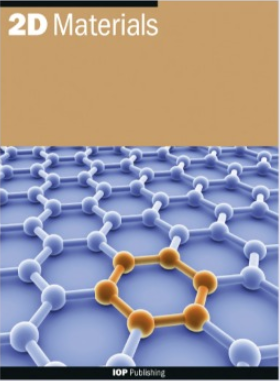MoS2 均硅层中的空间直接和混合激子-激子相互作用
IF 4.3
3区 材料科学
Q2 MATERIALS SCIENCE, MULTIDISCIPLINARY
引用次数: 0
摘要
过渡金属二卤化物(TMD)双层膜中的层间激子,以及它们与直接激子物种之间的相互作用,被认为提供了一条通向强非线性的途径,从而能够探索多体量子效应。我们对这些结构中各种激子之间的相互作用进行了理论研究,在这些结构中,库仑吸引力和排斥力都受到了减弱的屏蔽。对于同层 MoS2,我们研究了直接、空间直接和杂化激子,考虑了分布在一层或不同层的电子和空穴的直接和交换相互作用的影响。完全对齐的扭曲 TMD 异质层中也存在类似的物理现象,支持直接-间接激子杂化。在推导激子-外激子相互作用矩阵元素时,我们揭示了相互作用对转移动量的明显非单调依赖性,甚至对基态激子而言,其符号也从排斥变为吸引,并将我们的结果与现有的单层计算结果进行了比较。我们的研究结果表明,在涉及高密度效应(强相关相)的大动量情况下,相互作用主要受流行的吸引力交换成分支配。同时,在与稀疏系统更相关的小时刻,我们发现与层内非二极性激子相比,二极性物种的相互作用常数的增强可能会受到周围介质的阻碍。我们与现有实验进行了比较,并讨论了我们的发现对基于 TMD 的激子和激子-极化子系统中集体效应的影响。本文章由计算机程序翻译,如有差异,请以英文原文为准。
Spatially-indirect and hybrid exciton-exciton interaction in MoS2 homobilayers
Interlayer excitons in transition-metal dichalcogenide (TMD) bilayers, alongside their interplay with direct excitonic species, are supposed to offer a pathway towards robust nonlinearity, enabling the exploration of many-body quantum effects. We present a theoretical investigation of interaction among various exciton species within these structures where Coulomb attraction and repulsion are subject to reduced screening. For a homobilayer MoS2, we examine both direct, spatially-indirect, and hybridised excitons, considering the effects of direct and exchange interaction of electrons and holes distributed across one or different layers. Similar physics arises in perfectly aligned twisted TMD heterobilayers which support the direct-to-indirect exciton hybridisation. Deriving the exciton-exciton interaction matrix elements, we unveil a distinct non-monotonic dependence of the interaction on transferred momentum, changing sign from repulsive to attractive even for ground-state excitons, and compare our results with existing calculations for monolayers. Our findings demonstrate that for large momenta involved in high-density effects (strongly correlated phases), the interaction is chiefly governed by the prevailing attractive exchange component. At the same time, at small momenta that are more relevant for rarefied systems, we find that the enhancement of the interaction constant for dipolar species compared to intralayer non-dipolar excitons may be hindered by the surrounding medium. We draw comparisons with existing experiments and discuss the implications of our findings on the collective effects in TMD-based systems of excitons and exciton-polaritons.
求助全文
通过发布文献求助,成功后即可免费获取论文全文。
去求助
来源期刊

2D Materials
MATERIALS SCIENCE, MULTIDISCIPLINARY-
CiteScore
10.70
自引率
5.50%
发文量
138
审稿时长
1.5 months
期刊介绍:
2D Materials is a multidisciplinary, electronic-only journal devoted to publishing fundamental and applied research of the highest quality and impact covering all aspects of graphene and related two-dimensional materials.
 求助内容:
求助内容: 应助结果提醒方式:
应助结果提醒方式:


